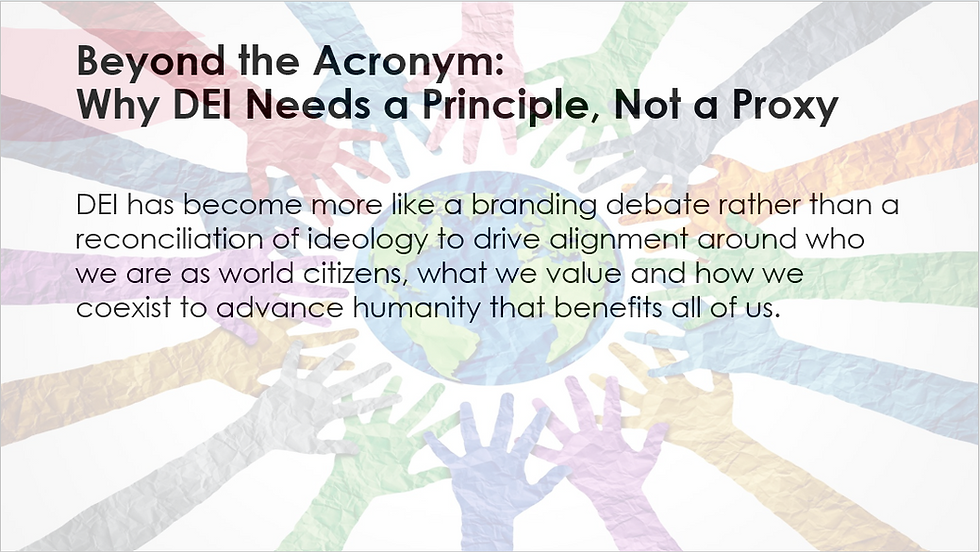The Intersectionality of DEI and Stakeholder Capitalism
- srjosephlawfirm
- Aug 15, 2022
- 3 min read
Updated: Aug 17, 2022
Navigating diversity as a business strategy is complicated for a variety of reasons, but one key reason has everything to do with balancing the messages communicated in diversity reporting with stakeholder capitalism. In other words, whose interests are being targeted and is it possible to satisfy multiple stakeholders, sometimes with competing interests, when setting a diversity strategy? This is a dilemma that reminds me of the competing interests oftentimes arising between business and legal objectives in contracting, a dilemma I am way too familiar with as a lawyer who has chosen to work in business roles – in this situation I am often challenged with balancing business decisions to absorb risks and layering in sufficient fencing in the contract to protect the bottom line.
Diversity impacts stakeholders in different ways and therefore the business risks of diversity (or a lack thereof) can potentially impact many factors in the bottom line. For example, employees are generally viewed as an organization’s greatest assets with impacts to the bottom line not only as revenue-generating but also as expense-incurring; when morale decreases, productivity takes a dive and both sides of the ledger may take a hit. Similarly, consumers have a direct impact on both revenue and costs with loyal customers driving high sales and revenue and complaints (or other dissatisfaction in consumers) having an adverse impact on sales and sometimes increasing costs, i.e., more marketing dollars allocated to recover from reputational damage to a brand. Other stakeholders like suppliers, distributors, alliance partners, regulators and the general community can also impact the bottom line when their interests are perceived as being neglected by an organization. And then there are the shareholders in public companies; for shareholders, the bottom-line is the primary interest because it's well-established that shareholders invest in companies to get a return on their investment. Thus, the interests of shareholders and other stakeholders can easily become misaligned. Nonetheless, advancing diversity causes do not have to be a dividing factor when it comes to the various interests of an organization's stakeholders. As a key stakeholder, boards of directors are not only the most up close and personal with the intersectionality of DEI and stakeholder capitalism, but Directors are also generally the accountable party for driving DEI initiatives and achieving diversity goals. Therefore, the Board, along with the responsible party for DEI (whether the CEO, the Chief Diversity Officer, HR, or a combination of any of these or other roles), should let the data be the guiding light in striking the right balance with stakeholder interests when setting and/or implementing their DEI strategy.
With a data-driven approach to diversity, a realistic aspiration toward stakeholder capitalism can be put into motion. That’s because the data will provide insights about where the gaps are in the context of clearly defined objectives for all stakeholders. The operative words here are “clearly defined”. If the north star is properly framed (that is, if the vision is clear) and leadership has stacked hands on it, then the next step to take is carefully articulating the message to stakeholders to ultimately drive the change toward business as usual; in simple terms, a well-crafted and timely change management plan is required to manage stakeholder messaging in order to achieve buy-in, adoption and embedding. By no means is this intended to sound like an easy journey because change in and of itself is hard. Diversity can add a layer of complexity as a result of the discomfort it may inherently create (depending on the levels of exposure to diversity of the targeted audience), which is almost always driven by the dichotomy of promoting differences over sameness as a benefit. It’s no secret that the natural tendency of human behavior is to lean in to the familiar and the similarities; and hence, going against what’s natural or what’s comfortable can be challenging. But this is where data can save the day with the necessary insights to glean where perceptions are mismatched to realities about diversity, equity and inclusion. And more importantly, these types of insights can serve as the basis for more targeted, transparent and valid diversity reporting, whether mandated or discretionary (corporate citizenship reporting, EEO-1 reporting, ESG reporting, SEC reporting, supplier diversity reporting, or other internal or external annual diversity reporting).
And much like the conflict often arising between legal and business objectives in contracting, there is an achievable balance to advancing diversity interests and succeeding with stakeholder capitalism. The key to striking the right balance is a data-driven DEI analysis – lead with analytics to drive a targeted and measurable, outcome-based business objective. With this approach, your organization will be enabled to create a diversity strategy that is sound and rational, data-based and bona fide. But most importantly, with a data-driven and measurable DEI approach you're equipped to not only report on diversity outcomes but also to adjust the bottom-line based on those outcomes as and when needed.



Comments